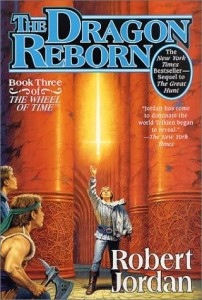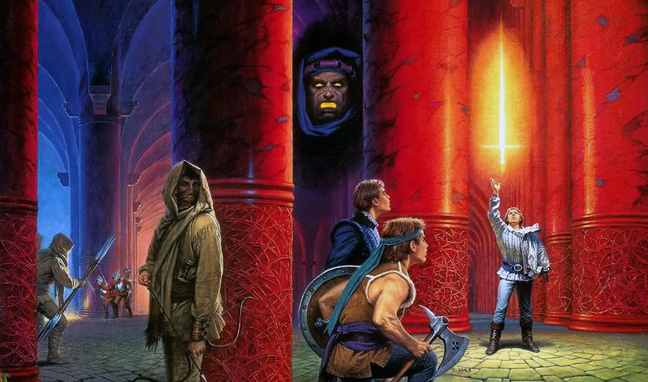
One of the interesting things about this re-reading project of mine is discovering how I have changed as a fiction reader and, to a lesser extent, as a critic over the course of the past decade or so. As I remarked in my reviews of The Eye of the World and The Great Hunt, some of the elements that used to irritate me greatly were not as noticeable this time around, while other plot and characterization issues that I had dismissed during my first few reads of the series seemed to be more visible during this current re-read.
One thing that I focused on as soon as I began this re-read was the notion that this massive twelve-volume series (and counting) could be divided into distinct narrative arcs. In particular, I was curious to see if the first three volumes might differ in their plot structures and presentation from succeeding volumes. To an extent, there is indeed an interesting interplay between these three early novels that I have not seen during my current re-reading of the fourth volume.
Seeing [Rand] struggle to fight for control of his double-edged magical powers through his actions and failures […] was a refreshing change.
The Dragon Reborn opens several weeks, if not months, after the Battle of Toman Head that concluded The Great Hunt. Rand al’Thor, who has now successfully fought off the EVIL Ba’alzamon, the presumed Dark One in this Manichean-style cosmos, twice in the previous two volumes, is still struggling to deal with the revelations of the past year. Born gifted/cursed with awesome power that is tainted for males, Rand constantly frets in the early chapters about his “destiny” as the reincarnated Dragon Reborn and the belief that the apocalyptic Last Battle was drawing nigh. Although Jordan continues to lapse into lengthy descriptive passages that fail to let the characters illustrate their conflicts through their actions, I found myself being more drawn into Rand’s plight that I ever remembered being when I last read this book a decade ago. Seeing him struggle to fight for control of his double-edged magical powers through his actions and failures more than through his internal monologues was a refreshing change.

But although the book’s title would lead the unwary reader to believe that the book will feature the Dragon Reborn prominently, Rand appears only in flitting scenes for three-quarters of the novel. Yet this was a wise decision by the author, as this allowed Jordan to explore the effects that Rand’s appearance at Toman Head had on the world around. Sometimes, instead of just rattling off paragraph after paragraph detailing what the central protagonist is to accomplish via mysterious prophecies, it might be best to let the überpowerful character take on the aspect of the looming 800 lb. gorilla in the room rather than dominating all of the proceedings. Jordan’s decision to switch the narrative focus away from Rand and toward those following him after his flight/quest to the city/state of Tear allows for a greater understanding of the events that are transpiring as a result of the destiny-bending powers of Rand and his two childhood friends.
 The basic structure of this novel is that of a classical epic fantasy quest narrative, except there are four main strains of quest being interwoven here. Besides Rand’s quest to discover for himself if he is truly the Dragon Reborn (to be proven by seizing the Arthurian-like Sword That Isn’t a Sword, contained within the Stone of Tear), there are the quests of Rand’s companions to track him down in time to protect him, the one involving the three young female trainees trying to sniff out the traitors in their midst, the conflicted desire of the previously-infected Mat to escape from Aes Sedai manipulation and to help his friends, and that of the fiercesome badass ninja-warriors, the Aiel, to track down their prophesied leader/destroyer. Unlike in The Great Hunt, where I felt the disparate narrative strands were not integrated well, here there is much more balance between these quests. Those of Rand and the Aiel are kept brief and fleeting, as befitting the characters of their quests. The ones involving Moraine/Perrin, Mat, and the three trainees receive more space, but none of these receive more than perhaps three chapters at a time, creating the sense that the action is moving swiftly and decidedly toward a resolution.
The basic structure of this novel is that of a classical epic fantasy quest narrative, except there are four main strains of quest being interwoven here. Besides Rand’s quest to discover for himself if he is truly the Dragon Reborn (to be proven by seizing the Arthurian-like Sword That Isn’t a Sword, contained within the Stone of Tear), there are the quests of Rand’s companions to track him down in time to protect him, the one involving the three young female trainees trying to sniff out the traitors in their midst, the conflicted desire of the previously-infected Mat to escape from Aes Sedai manipulation and to help his friends, and that of the fiercesome badass ninja-warriors, the Aiel, to track down their prophesied leader/destroyer. Unlike in The Great Hunt, where I felt the disparate narrative strands were not integrated well, here there is much more balance between these quests. Those of Rand and the Aiel are kept brief and fleeting, as befitting the characters of their quests. The ones involving Moraine/Perrin, Mat, and the three trainees receive more space, but none of these receive more than perhaps three chapters at a time, creating the sense that the action is moving swiftly and decidedly toward a resolution.
It is in this novel that the quest narrative structure that had dominated to date begins to shift. More is seen of the setting’s environs and particularly the increasingly bad situations that the common people experience. Jordan is often (and rightly) criticized for taking too much of a “theme park” approach to his setting. The characters move from locale to locale, see a few of the local monuments, interact with maybe a couple of locals, fight off a group of baddies and then they move on. But here, and this is especially true in Mat’s later scenes, more detail is given to the “outside” world. Short passages such as the one involving the refugees at a local port and their desperate cries for food and other supplies is touching, as this is one of the few times that I recall in the series (perhaps I’ll remember more as I re-read the other volumes) where the human suffering is shown rather than told in passing by a character. The turbulence brought by Rand’s emergence and by the nefarious counterstrokes of the EVIL opposition are shown to good effect here.
It wouldn’t surprise me to learn if it was around this point that several readers became ardent fans of the series.
However, this should not excuse several problems that I noted in this book. First, the prose continues to be pedestrian. Often, too much description is wasted on minor characters and not enough attention is given to the dialogues. In particular, the EVIL Forsaken and their servants sound more like caricatures of movie villains than anything resembling a well-rounded, complex character. The usual complaints I’ve heard over the years from other readers about the repetitive physical tics (sniffing, braid tugging, and the like) would apply nicely to a few scenes here. It is unfortunate that the author failed to develop other ways to express his characters’ emotional states, as after a while, the repetitive complaints about how X “knows women better than I do” or “Men!” or any other similar expression tends to numb some readers (or at the very least, this reader), leading to several dull moments within what should be a rollercoaster-style narrative.
Although these complaints really are endemic to the series as a whole, they do not affect my enjoyment of The Dragon Reborn. In fact, I would have to say out of the three novels read so far, my opinion of this one improved the most. It still contains several annoying flaws, but these don’t impede the narrative flow and plot developments as much as I fear future volumes might (again, based on faint memory). It wouldn’t surprise me to learn if it was around this point that several readers became ardent fans of the series, as there are enough intriguing developments that begin to veer away from the traditional quest narrative as to make me curious about how I’ll receive the next three, mammoth volumes. No waning in interest so far.

